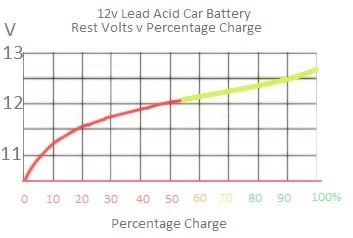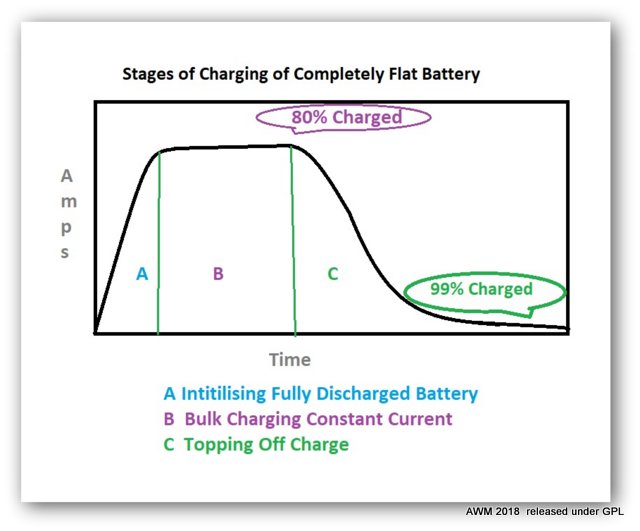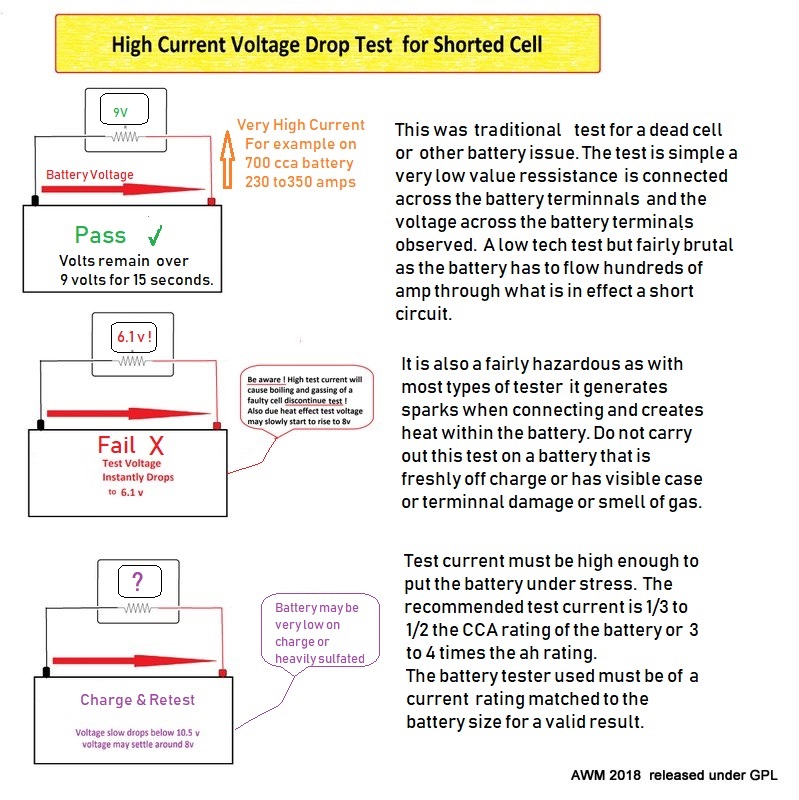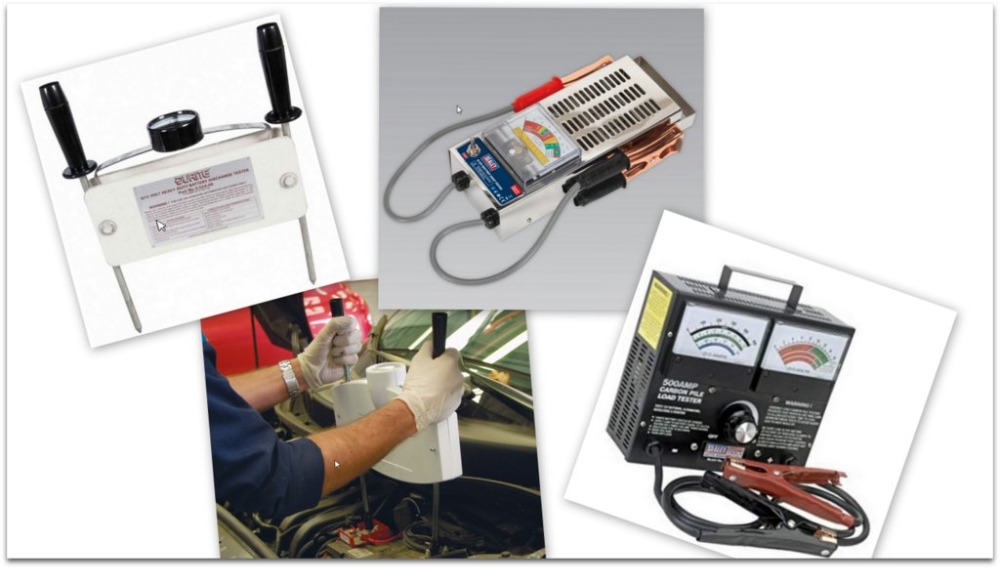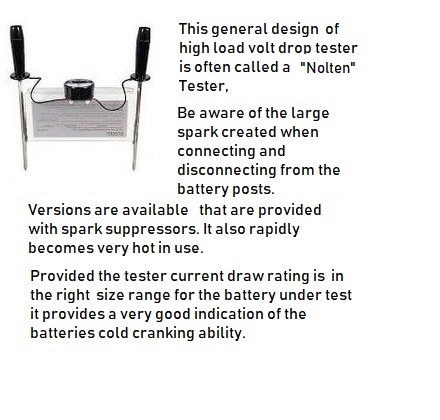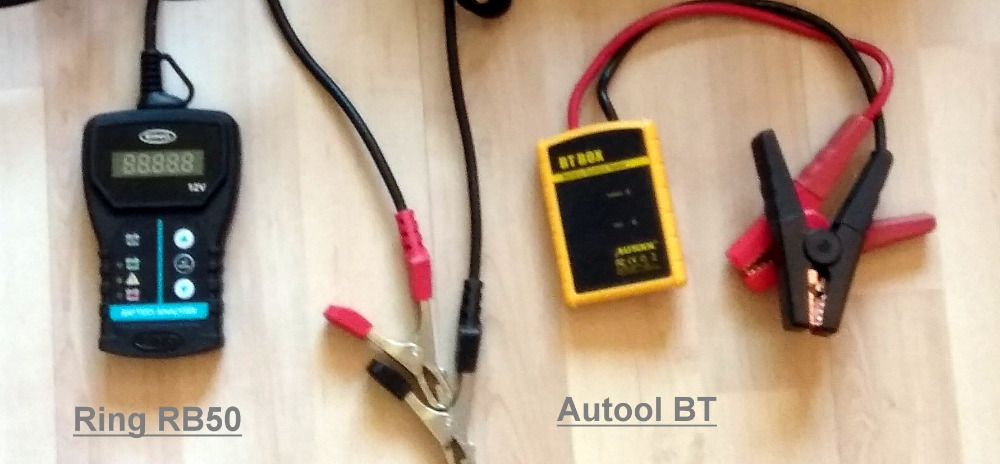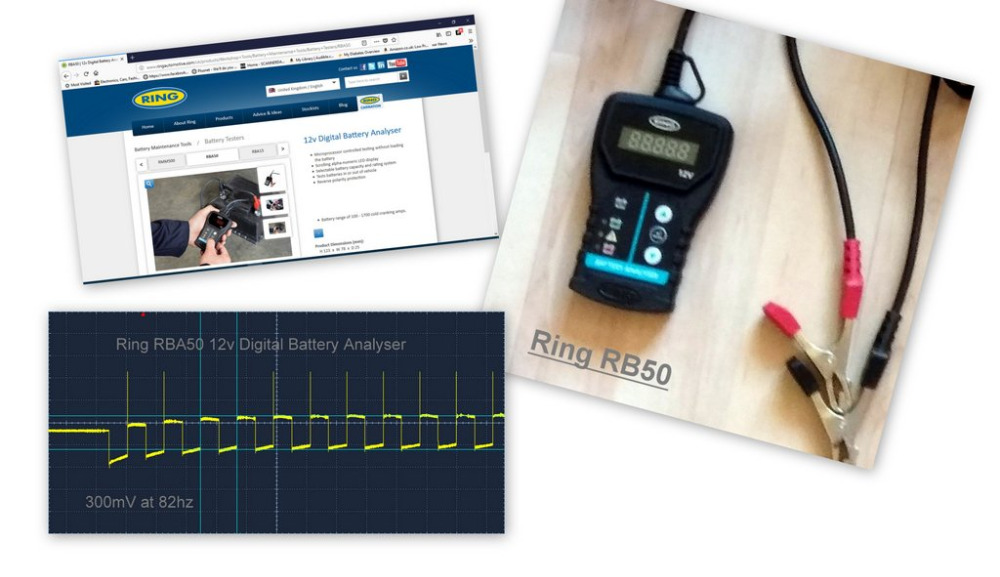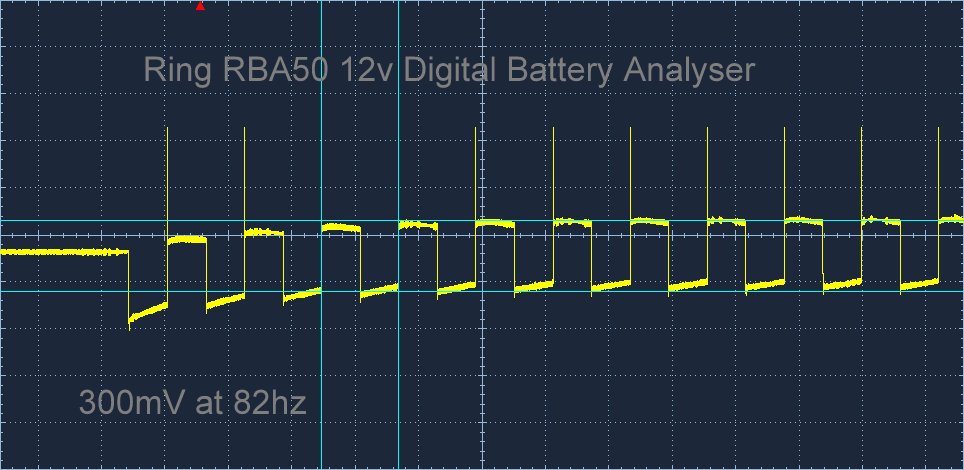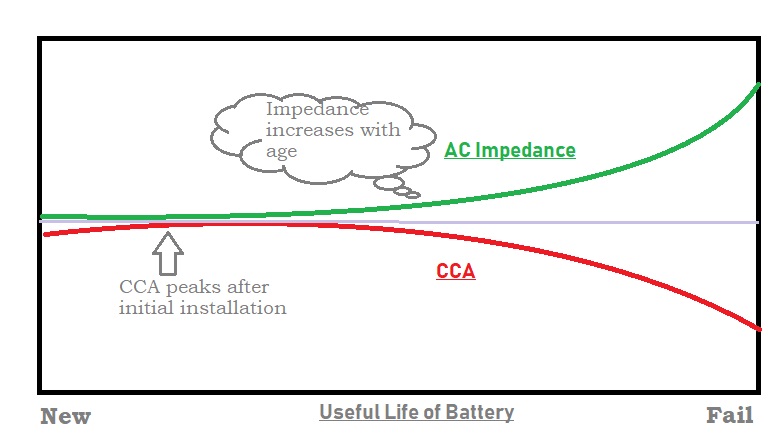Car Battery basics Part1
- Andy.MacFadyen
-
 Topic Author
Topic Author
- Offline
- Moderator
-

- Posts: 3353
- Thank you received: 1037
Lead-Acid batteries have been the standard fitting in cars for about 130 years. A cell on a lead-acid is made up from one plate of porous lead facing a plate of lead oxide immersed in sulfuric acid.
A traditional Lead-Acid cell when fully charged produces about 2.1 Volts. To make a 12v battery we need 6 cells connected in series 6 x 2.1 = 12.6v. This 12.6v “rest” voltage is typical of a good healthy fully charged battery but the output voltage depends on the temperature and State of Charge - Open Circuit Rest Voltage
Estimating State of Charge
For the tech working with modern sealed batteries the rest voltage is the only viable way of estimating what the batteries “state of charge” . For the tech or mechanic checking the battery voltage before you do any diagnosis or repair on a vehicle is always smart move, A battery showing a no load voltage of 10.5v or less is completely discharged, below 10.5v especially with modern batteries the battery will suffer damage, possibly to extent it cannot be recharged. If in doubt before working on the vehicle connect a charger and charge the battery at a low amps setting.
Rest Voltage v Surface Charge.
When a battery has been recent charged either from the alternator or a battery charger it will show a voltage higher than the rest voltage for anything from minutes to several hours afterwards, this is caused by a charge on the plate surface that hasn’t yet penetrate into the bulk of the plate material. As a rule of thumb if you watch battery voltage the on a car with a good battery and charging system the voltage will drop from about 13.8 -14.9v engine running, to about 12.9-13.1v immediately the after engine stops then more slowly to 12.4-12.7v after the engine has be stopped for a few minutes.
How to Quickly Remove the Surface Charge
If the battery is to be tested immediately to get a true picture of the health and state of charge of the battery the surface charge can be removed by switching on the headlights for about 3 minutes before testing. If the battery voltage drops fairly quickly after switching on the head lights this is a good indication of a problem with the battery usually a shorted cell also sometimes called a “gassing” or “boiling” or “dead” cell.
Fully Charged Rest Voltage v % Estimated State of Charge
NB Voltage will vary with temperature --- low temperatures = lower voltage, higher temperatures = higher voltage.
This chart shows the charge % v Rest Voltage relationship at around 30c or 70f If the battery is really cold, ie somewhere around 0c/32f add 0.1v to the measured voltage.
" We're trying to plug a hole in the universe, what are you doing ?. "
(Walter Bishop Fringe TV show)
Please Log in or Create an account to join the conversation.
- Andy.MacFadyen
-
 Topic Author
Topic Author
- Offline
- Moderator
-

- Posts: 3353
- Thank you received: 1037
Until a few years ago Lead-Acid vehicle batteries were divided into Starting Batteries and Deep Cycle Leisure Batteries.
Engine Starting Batteries
Starting batteries are exactly what it says on the tin they are designed for starting engines ie. to withstand a huge current draw for a short time followed by immediate recharging from the alternator. Starting batteries suffer serious damage if deeply discharged below 50% or about 12.1v
RV and Boat Leisure Batteries
Leisure batteries are intended for supplying the domestic uses on RV’s and boats. They are designed to supply current at a lower amperage than starting batteries but for longer periods and can be deeply discharged and recharged with much less damage to the batteries ability to store charge. Most boats have master switch that allows the leisure battery to boost the engine starter battery in an emergency but doing so is likely to damage the leisure battery.
Deep Discharge Damage
Every discharge & recharge cycle no matter small damages the battery and reduces the energy (the Amp Hours) the battery can store. The damage to a battery with normal discharges is small but if a normal Lead-Acid automotive starting battery is repeated drained to below 60% charge the damage becomes noticeable.
Damage to a battery from a deep discharge can be reduced by recharging as soon as possible however using a high amp boost charger is likely to cause more damage.
" We're trying to plug a hole in the universe, what are you doing ?. "
(Walter Bishop Fringe TV show)
Please Log in or Create an account to join the conversation.
- Andy.MacFadyen
-
 Topic Author
Topic Author
- Offline
- Moderator
-

- Posts: 3353
- Thank you received: 1037
How well a battery cranks an engine depends greatly on temperature, at freezing point (0c or 32f) a new fully charged battery will only have 80% of its’ performance at room temperature. In really cold winter conditions -20c or -4f the performance drops to 55%. If the battery has only a partial charged in semi-arctic conditions the battery electrolyte can also freeze. Don’t attempt to charge or jump start a frozen battery without first thawing it out.
In an effort to improve cranking performance in cold start conditions from around 1990 battery manufacturers introduced calcium doping to the lead plates, to replace the antimony additives previous used.
Lead Acid Calcium Batteries ---Double Calcium
With calcium doping of both anode and cathode battery plates cold cranking performance improves over the classic lead acid type. Other major advantages of this type are they retain their charge better when in storage , they operate best with a higher charging voltage and are more tolerant of overcharging without excessive loss of electrolyte.
However calcium batteries require a slightly higher charging voltage (14.8V) to reach 100% charge. The major disadvantages are these batteries generally have a shorter life and if fully discharged type of battery very quickly becomes damaged, often beyond recovery due to sulfation.
Lead Acid Calcium Batteries ---Hybrid Calcium
To alleviate this problem improved variations of the type were devised, these included adding silver to the doping of the to improve strength and so called hybrid calcium type where the positive anode plates use the traditional antimony doping, only the negative cathode plates are calcium doped. The performance of this type of battery in cold cranking conditions falls somewhere between old style lead-acid and the double calcium type, also although in long term storage it retains its charge for much longer than a conventional lead-acid type it still will self-discharge more quickly than the calcium-calcium type.
If completely flattened this type of battery can often be recovered by charging.
" We're trying to plug a hole in the universe, what are you doing ?. "
(Walter Bishop Fringe TV show)
Please Log in or Create an account to join the conversation.
- Andy.MacFadyen
-
 Topic Author
Topic Author
- Offline
- Moderator
-

- Posts: 3353
- Thank you received: 1037
Gel batteries are/were specialist lead acid batteries that have been used used in motorcycle, car racing and aviation they were semi-sealed and used a gel electrolyte and as a result were spill proof and could even be mounted on their side. Although they had advantages in terms of safety and low weight they could be easily damaged by over charging and for automotive uses they have largely been supplanted by AGM batteries. ---
EFB and AGM - The new kids on the stop-start block.
The demands of stop-start system on recent vehicles places huge demands on batteries which the existing lead-acid types were unable to meet.
AGM (Absorbent Glass Mat)
An AGM battery is a lead-acid battery but the electrolyte is held in glass fibre mats which are clamped between the plates. The result is a much tougher plate construction that can deliver higher cold cranking amps and can be recharged at a much higher rate of amps and survive deeper discharge-recharge cylces better than conventional starter batteries. This type of plate construction is also more resistant to damage from vibration making it very suitable for use on diesel engine vehicles.
Because the electrolyte is contained in glass mats like the gel battery it is also spill proof and can be mounted at any angle. AGM batteries are ideally charged at a slightly higher voltage than other lead-acid batteries. A big advantage of AGM batteries is they hold charge while in storage for much longer than any other lead-acid battery up to almost a year between topping up charges which is good news for classic car owners, RV owners and battery retailers. As a result AGM is the currently the battery of choice for high end vehicles loaded with stop-start and other high electrical demands.
The disadvantage to AGM types is cost currently AGM types are around twice the price of a mid-range conventional battery. The life expectancy of an AGM battery is at least twice that of a premium grade conventional battery from the same manufacturer.
EFB (Enhanced Flooded Battery)
A lower cost alternative to AGM for start-stop applications and as the name implies it is a much improved conventional battery. The changes include the addition of tin and carbon to a reinforced plate structure. The result is a battery that can survive deeper discharges and accept recharging at a much higher rate of amps than a traditional flooded lead acid type. The charging voltage requirements for EFB batteries is inline with conventional flooded lead acid batteries. Yuasa Batteries recommend EFB batteries for retrofitting in Taxis and Police cars. Currently cost lies halfway between a premium grade battery and an AGM type
" We're trying to plug a hole in the universe, what are you doing ?. "
(Walter Bishop Fringe TV show)
Please Log in or Create an account to join the conversation.
- Andy.MacFadyen
-
 Topic Author
Topic Author
- Offline
- Moderator
-

- Posts: 3353
- Thank you received: 1037
Comparing battery specifications for batteries of the same case size can be confusing and misleading made even more confusing because of the dozen or different standards used. Also be aware that these ratings are based on tests carried out in-house by the manufacturer not an outside agency.
The main measure that need to be considered when selecting are cranking power the battery can deliver in a cold weather and how much electrical energy the battery can store. The weight of the battery is also a useful indicator of how much lead the battery contains which is generally a sign of reliable performance and longevity.
CCA --- Cold Cranking Amps
The most common measure of cold weather cranking power is Cold Cranking Amps (CCA), if you live in an area the is subject to extreme cold weather CCA is important. The problem with CCA is there are several different standards the main ones are CCA (SAE), EN and DIN. Because of the confusion most battery manufacturers quote the SAE version of CCA but increasingly batteries are listed with EN1 ratings. The EN and DIN tests are tougher than the SAE test so give lower numbers. All these tests are all performed at 0f (-18c) so are a realistic indicator of cold weather cranking. When selecting or testing a battery I have always used the CCA using this table to convert.
Link to CTEK CCA Conversion Table
Calcium batteries give noticeably better CCA performance than conventional types in semi-arctic conditions, CCA is very important in cold climates but is generally less of a priority in climates with warmer winters. However in all climates the reserve of energy a battery can store without becoming discharged is important this is indicated by the Amp Hours (AH) or Reserve Capacity (RC) rating of the battery.
" We're trying to plug a hole in the universe, what are you doing ?. "
(Walter Bishop Fringe TV show)
Please Log in or Create an account to join the conversation.
- Andy.MacFadyen
-
 Topic Author
Topic Author
- Offline
- Moderator
-

- Posts: 3353
- Thank you received: 1037
Two methods are used to estimate how much energy car battery can store both are based on the time a battery can supply a nominal voltage and current.
In the USA the Reserve Capacity is often specified as the RC number which is simply the time in minutes a new fully charged battery at 25C (77f) can supply 25 Amps before it drops below 10.5v. It was originally devised as a measure of the get you home capacity of a event of a charging system failure.
In the UK and many other parts of the world the Amp Hour rating is used although essentially measuring the same thing the testing method is different and the time is fixed and the current varied. Normally automotive starting batteries are tested over 20 hours. A typical starting battery in a car between 2 and 3 litres will have around 70ah capacity this means in a 20 hour test a new fully charged battery at 35c/77f should be able to supply 3.5 Amps for 20 hours before dropping below 10.5 volts.
Because of the characteristics of lead acid batteries under different loads these ratings although measuring similar properties can’t be converted from one to the other but more is good in both cases.
Battery Quality & Longevity
Battery quality depends not only on the manufacturer the product range the battery is from. It goes without saying that a reputable establish manuafacture such as Varta, Bosch, Exide, Yuasa, Delco are the first that come to mind but more recently here in the UK we are offered Duracell and Hankook. Going back to our typical 2 to 3 litre European car all these companies can supply different batteries from different price ranges for this fitment. Most of these manufacturers can supply this fitment (UK Type code 096) from 5 different prices ranges with warranties lasting from 3 to 5 years.
Battery Warranties
Battery warranties are pro-rata and are heavily biased in favour of the battery manufacturer but they are a good guide to quality and life expectancy.
Weight
Batteries sold for this application vary in weight from about 16.5 kg to 22.5 kg this is a good indicator of the lead content of the battery and the amount of material used in the grid structure, which are both important factors in battery's useful life and performance.
" We're trying to plug a hole in the universe, what are you doing ?. "
(Walter Bishop Fringe TV show)
Please Log in or Create an account to join the conversation.
- Andy.MacFadyen
-
 Topic Author
Topic Author
- Offline
- Moderator
-

- Posts: 3353
- Thank you received: 1037
Health & Safety
Lead-Acid Batteries contain sulfuric acid and also produce hydrogen and oxygen which can be under pressure which is not a good combination especially when the potential exist for an electrical spark. When I worked in the airport industry one our mechanical fitters had lost the vision in one eye a result of a starting battery on stand-by fire pump exploding while he was removing it from float charge.
So take care: (1) Don’t over charge (2) Don’t attempt to charge a frozen or swollen battery (3) Don’t charge if the battery or ambient temperature is above 50c (122f) (4) Don’t disconnect a battery while it is charging, switch off at the charger or power socket before disconnecting. (5) If you smell or see signs of the battery gassing or over heating or swelling switch off the charger at the power socket and allow the gasses to dissipate and the battery to cool any any internal pressure to reduce.
Initial Charging & Recharging Completely Discharged Batteries.
A 12v lead acid battery is not a resistor it is not a capacitor it is a chemical reaction in a box, this becomes apparent when attempting to recover a completely discharged battery which is a slow and sometimes difficult process or in the case of calcium type often impossible. Additionally most modern fully automatic “smart” chargers will refuse to charge a completely discharged battery (see section on smart chargers) unless tricked into doing so.
When a battery is new or completely discharged the cathode(-) and anode (+) plates are not in a condition to accept charge. The charging current will sit at or near zero until after some time has passed the battery starts to accept charge and the charging current ramps up. Normally the vast majority of batteries you will encounter will have some charge remaining and will go directly into the next stage the constant current or bulk charging stage.
Constant Current or Bulk Charging Stage
In the bulk constant current stage the battery accepts a fairly constant current until it reaches around 80% charge at which point it will naturally taper off as it approaches a fully charged state. Depending on how much charge the battery had at the start of re-charging this stage can take up to 3 to 4 hours to fully complete. At the end of this constant current stage depending on the battery charger type and setting and also the battery type the voltage measured across the battery terminnals will have risen to somewhere between 14.2 and 14.9 volts
Topping off or Constant Voltage Phase
The next stage to top off the remaining 20% of charge takes longer. Only when the charge current drops below 2 to 3% of the ah rating (for our example on 70ah battery 1.5 to 2 amps) the battery can be regarded as charged. To fully complete this stage can take an additional 4 to 5 hours.
Taking our 70ah car battery as an example the constant current phase should ideally be about ah/20 (3 to 4 amps) but ah/10 (6 to 8 amps) will not cause excessive damage and ah/5 (up 18 to 20 amps) for a few minutes. Using the very high current starter booster setting on powerful shop chargers is a last resort measure it is very bad for the battery and causes over voltage in the cars electrical system.
Charging VoltageThe ideal battery peak charging voltage for most tradditional automotive car and truck lead acid batteries in temperate climate is 14.2 to 14.6 volts.
In freezing conditions this can be increased to 14.8 volts many modern automatic “Smart” chargers have * Winter setting for charging in sub or zero conditions. With old style “dumb” chargers you can simply select a suitable higher setting.
Charging AGM Batteries
AGM batteries are ideally charged at higher voltage 14.6 to 14.8v if using a “Smart” charger without an AGM setting use the * Winter setting if present.
Small Batteries & Gel Batteries
When charging motorcycle and other small batteries 0.8 to 1.0 amp is normal with 1.8 amps generally regarded as the absolute maximum charging current. Because they are easily damaged by over heating Gel batteries charge best at 14.4 to 14.5 and need extra care to avoid over charging.
" We're trying to plug a hole in the universe, what are you doing ?. "
(Walter Bishop Fringe TV show)
Please Log in or Create an account to join the conversation.
- Noah
-

- Offline
- Moderator
-

- Give code definitions with numbers!
- Posts: 4959
- Thank you received: 1111
"Ground cannot be checked with a 10mm socket"
Please Log in or Create an account to join the conversation.
- Andy.MacFadyen
-
 Topic Author
Topic Author
- Offline
- Moderator
-

- Posts: 3353
- Thank you received: 1037
Noah wrote: You are an incredible wealth of knowledge sir! Thank you for taking the time to share it with us, very informative read.
Really just what my grandad. father and uncle taught me with a the modern stuff from a few internets sites --- mainly from "Yuasa UK" and " "Battery University" The next stage is to look at battery chargers and high and low tech methods of diagnosing battery issues.
" We're trying to plug a hole in the universe, what are you doing ?. "
(Walter Bishop Fringe TV show)
Please Log in or Create an account to join the conversation.
- Andy.MacFadyen
-
 Topic Author
Topic Author
- Offline
- Moderator
-

- Posts: 3353
- Thank you received: 1037
Over years of use even if not subject to neglect or abuse the number of amp hours a battery can store becomes smaller although the open circuit rest voltage may remain unchanged. In normal automotive batteries a drop to 40% of the original amp hour capacity is considered the cut off point for replacement. In effect our example 70 ah battery shrinks to 28 ah. Even at only 20 to 30% capacity the battery may still continue to start the car in normal use but it will have no reserve capacity if for example the lights are left on for even a short period. When maintaining emergency service vehicles and other critical applications a higher percentage of original capacity should be chosen as the cut-off point.
" We're trying to plug a hole in the universe, what are you doing ?. "
(Walter Bishop Fringe TV show)
Please Log in or Create an account to join the conversation.
- Andy.MacFadyen
-
 Topic Author
Topic Author
- Offline
- Moderator
-

- Posts: 3353
- Thank you received: 1037
A Dead cell also known as a shorted or gassing cell is when the sulfation or buckling of the battery plates causes a 6 cell battery to function as a 5 cell battery. This used to be the most common type of battery failure causing a no crank no start. With only 5 working cells the remaining cells recieve a higher charging voltage and have a higher than normal surface charge which will mask the effects of the dead cell until heavy demands are placed on the battery by cold weather or the vehicle parked for more than a few hours.
" We're trying to plug a hole in the universe, what are you doing ?. "
(Walter Bishop Fringe TV show)
Please Log in or Create an account to join the conversation.
- Andy.MacFadyen
-
 Topic Author
Topic Author
- Offline
- Moderator
-

- Posts: 3353
- Thank you received: 1037
" We're trying to plug a hole in the universe, what are you doing ?. "
(Walter Bishop Fringe TV show)
Please Log in or Create an account to join the conversation.
- Andy.MacFadyen
-
 Topic Author
Topic Author
- Offline
- Moderator
-

- Posts: 3353
- Thank you received: 1037
These tools are from the reputable UK brands Durite and Sealey
" We're trying to plug a hole in the universe, what are you doing ?. "
(Walter Bishop Fringe TV show)
Please Log in or Create an account to join the conversation.
- Andy.MacFadyen
-
 Topic Author
Topic Author
- Offline
- Moderator
-

- Posts: 3353
- Thank you received: 1037
" We're trying to plug a hole in the universe, what are you doing ?. "
(Walter Bishop Fringe TV show)
Please Log in or Create an account to join the conversation.
- Andy.MacFadyen
-
 Topic Author
Topic Author
- Offline
- Moderator
-

- Posts: 3353
- Thank you received: 1037
" We're trying to plug a hole in the universe, what are you doing ?. "
(Walter Bishop Fringe TV show)
Please Log in or Create an account to join the conversation.
- Andy.MacFadyen
-
 Topic Author
Topic Author
- Offline
- Moderator
-

- Posts: 3353
- Thank you received: 1037
" We're trying to plug a hole in the universe, what are you doing ?. "
(Walter Bishop Fringe TV show)
Please Log in or Create an account to join the conversation.
- Andy.MacFadyen
-
 Topic Author
Topic Author
- Offline
- Moderator
-

- Posts: 3353
- Thank you received: 1037
" We're trying to plug a hole in the universe, what are you doing ?. "
(Walter Bishop Fringe TV show)
Please Log in or Create an account to join the conversation.
- Andy.MacFadyen
-
 Topic Author
Topic Author
- Offline
- Moderator
-

- Posts: 3353
- Thank you received: 1037
These testers are have become very popular over the last 20years, they work by super imposing and AC square wave one the battery voltage to measure the the AC impedance of the battery and using this to estimate the CCA of the battery and remaining life left in the battery.
Impedance is the equivalent of resistance to an AC signal. In theory this type of tester will work on batteries that are below 50% charge.
I have been using this type of tester for about 5 years a RIng RBA50 Link to RBA50 on Ring Automotive UK Website
Using this type of test tool is simple
Step (1) Connect to battery
Step (2) Tester displays battery open circuit voltage, as a guide to state of charge of battery.
Step (3) Tester prompts to select CCA unit of battery ie CCA, EN, DIN....
Step (4) Tester prompts to select CCA value.
Step (5) Presss enter and test starts
Step (6) Tester displays Pass or Fail, % of Battery Life Remaining and Estimated Actual CCA.
The tool is powered by the batteries own voltage and using an oscilloscope reveals it places a 300mv AC 82hz square wave across the battery terminnals.
" We're trying to plug a hole in the universe, what are you doing ?. "
(Walter Bishop Fringe TV show)
Please Log in or Create an account to join the conversation.
- Billy R
-
- Offline
- New Member
-

- Posts: 1
- Thank you received: 0
Please Log in or Create an account to join the conversation.
- ken1
-
- Offline
- New Member
-

- Posts: 15
- Thank you received: 4
read batteries?
Please Log in or Create an account to join the conversation.

